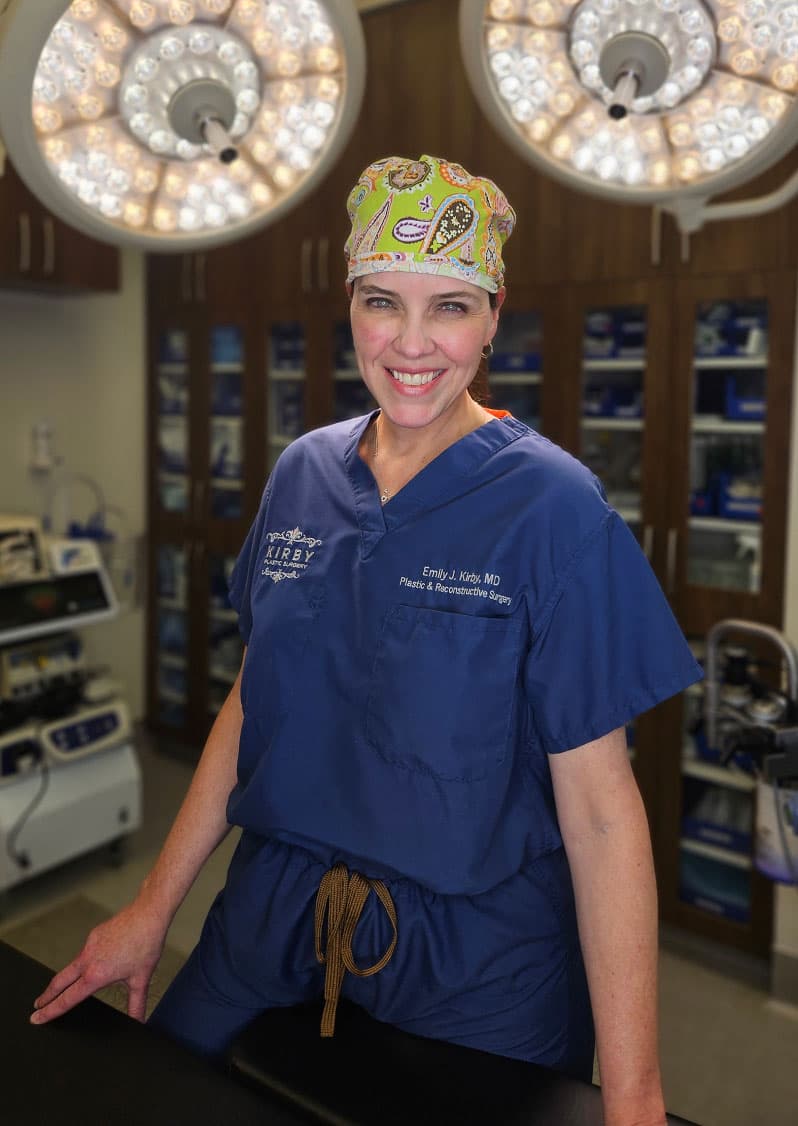Fat Transfer Breast Augmentation Fort Worth

What if you could reduce unwanted fat in your lower body and increase your breast size, all in the same procedure? Fat transfer breast augmentation, or fat grafting, is a type of breast augmentation technique that transfers fat from your stomach, hips, or thighs to your breasts. By moving fat from areas of the body that typically have a little extra cushion to the breasts, female Board Certified Plastic Surgeon Dr. Emily J. Kirby is able to naturally increase volume and shape in the breasts, while contouring the rest of your figure.
How is fat transfer breast augmentation performed?
Fat transfer breast augmentation is performed as a multi-step procedure:
Step 1: Liposuction is performed to remove excess fat from your abdomen, hips, or thighs.
Step 2: Your harvested fat is carefully separated and prepared.
Step 3: A few tiny incisions are made around the armpit, the outside margins of your breast, and/or the areola to inject your harvested fat.
Step 4: Fat is injected throughout the breast and at different skin depths in a precise, layered manner to ensure it maintains its volume and viability.
Female Plastic Surgeon Fort Worth
- Board-Certified Plastic Surgeon
- Over 12 years of experience in private practice
- Founder and Medical Director of Kirby Plastic Surgery, Kalos Medical Spa, and City Surgery Center—a Quad A-accredited, state-of-the-art facility located onsite
- Specialist in breast surgery and body contouring, including postpartum
- Castle Connolly Top Doctor since 2019
- First female Chief of Plastic Surgery, Texas Health Resources Harris Methodist Hospital
What kind of anesthesia will I have?
Dr. Kirby performs fat transfer breast augmentation using general anesthesia for optimal comfort and safety. This means you will be asleep for the entire procedure.
What are the benefits of fat transfer breast augmentation?
Fat transfer breast augmentation offers numerous benefits, including:
- Gives your surgeon more control over shaping your breasts
- Can provide a more natural breast augmentation appearance
- Considered a safe procedure because your own fat is used to volumize the breasts instead of implants
- Can improve the appearance of implant rippling or other contour deformities
- Can correct mild asymmetry or slight unevenness in the breasts
- Requires only a few small, well-concealed incisions
Am I a good candidate for fat transfer?
You may be a good candidate for fat transfer breast augmentation if you:
- Want to increase volume and shape in your breasts without implants
- Desire a natural look and feel to the breasts
- Are a non-smoker
- Have excess fat on your hips, thighs, or abdomen
- Are at a stable weight
- Want to reduce the appearance of implant rippling
Fat transfer to the breasts is also a popular procedure for patients who want to reconstruct their breasts after a mastectomy.
Real patient images from Board-Certified Plastic Surgeon Dr. Emily Kirby
*Individual results may vary.
What other areas of the body can I enhance with fat transfer?
In addition to augmenting your breasts with your own body fat, fat can be transferred to the butt (Brazilian butt lift surgery, or BBL) and to the face (facial fat transfer).
Dr. Emily Kirby uses Enhanced Recovery After Surgery (ERAS) protocols, also known as “multimodal analgesia,” to minimize recovery time, and we see real results: our patients experience less nausea and feel more alert, mobile, and comfortable after their procedures.
“I had very hard recoveries in the past…it took me weeks to get back to caring for my family. With Dr. Kirby, I had a wonderful recovery and was back to my activities surprisingly quickly. Don’t tell the doctor, but I was at my child’s sporting event the day after my surgery, and I felt great!”
—Real patient of Dr. Kirby
Fat transfer breast augmentation recovery & results
Since fat must be placed in small amounts and in a “layered” manner, fat transfer breast augmentation may require more than one treatment in order to achieve your desired volume. However, recovery is typically shorter than breast augmentation with implants because there is no irritation of the muscles.
After your surgery, you should expect to have some swelling, bruising, and temporary changes in sensation in the breasts and in the areas that were treated with liposuction. These side effects typically subside within a few days to a couple of weeks. Most patients can return to a desk job and light activities within a few days. Most of our patients see full results after about 6 months.
Dr. Kirby will place a compression garment over areas where liposuction was performed; they should be worn for about 6 weeks after your procedure to help flatten and smooth out these areas. A post-surgical bra is placed to help your newly enhanced breasts take shape. Scars under the breast or around the nipple are easily hidden by a swimsuit or bra, and often by the breast shadow itself. Dr. Kirby will go over your scar care plan and options to help ensure that your scars heal as beautifully as possible.
Following your fat transfer breast surgery, it is important to maintain a stable weight, as weight loss can reduce volume in the breasts.
References »
Tan SS, Ng ZY, Zhan W, Rozen W. Role of Adipose-derived Stem Cells in Fat Grafting and Reconstructive Surgery. Journal of Cutaneous and Aesthetic Surgery. 2016 Jul-Sep;9(3):152-156. doi: 10.4103/0974-2077.191672.
Simonacci F, Bertozzi N, Grieco MP, Raposio E. From liposuction to adipose-derived stem cells: indications and technique. Acta Biomedica. 2019 May 23;90(2):197-208. doi: 10.23750/abm.v90i2.6619.
Nemir S, Hanson SE, Chu CK. Surgical Decision Making in Autologous Fat Grafting: An Evidence-Based Review of Techniques to Maximize Fat Survival. Aesthetic Surgery Journal. 2021 May 18;41(Suppl 1):S3-S15. doi: 10.1093/asj/sjab080.
Hanson SE. The Future of Fat Grafting. Aesthetic Surgery Journal. 2021 May 18;41(Suppl 1):S69-S74. doi: 10.1093/asj/sjab130.
Dayal A, Bhatia A, Hsu JT. Fat grafting in aesthetics. Clinics in Dermatology. 2022 Jan-Feb;40(1):35-44. doi: 10.1016/j.clindermatol.2021.08.010.
- Key Benefits
- Glossary
- Natural-looking increase in breast size, without breast implants
- Dual benefit of liposuction in areas like the abdomen, flanks, or thighs
- Minimal scarring compared to traditional breast augmentation surgery
- Adipose Tissue: Body fat or fatty tissue, which is harvested through liposuction from one area of the body and transferred to the breasts in this procedure.
- Autologous Fat Transfer: The process of using the patient’s own fat, extracted from another part of their body, to enhance the size and shape of the breasts.
- Cannula: A thin, hollow tube used to extract and inject fat during the fat transfer process.
- Centrifugation: A process used to purify the harvested fat before injection into the breasts, separating viable fat cells from blood, oil, and other fluids.
- Donor Site: The area(s) of the body from which fat is harvested for transfer, commonly the abdomen, thighs, or flanks.
- Fat Grafting: Another term for autologous fat transfer, specifically referring to the injection of purified fat cells into another area of the body, such as the breasts, for augmentation.
- Fat Necrosis: The death of fat cells that have been transferred to a new area, which can sometimes occur after fat grafting, potentially leading to firmness or lumps.
- Liposuction: The surgical removal of fat from specific areas of the body, used in fat transfer breast augmentation to harvest fat from the donor site.
- Local Anesthesia: Medication administered to prevent pain during surgery by numbing a small area; it may be used in combination with sedation to minimize discomfort if preferable over general anesthesia.
- Microfat Grafting: A technique used in fat transfer that involves injecting small amounts of purified fat into tissues to enhance accuracy and survival rate of the fat cells.
- Recovery Time: The period after the procedure during which the body heals; for fat transfer breast augmentation, this includes time for swelling to subside, and for the patient to gradually return to normal activities, typically ranging from a few days to several weeks. Recovery can be streamlined, but not rushed.
- Rejection: Unlike with synthetic materials, the risk of rejection is minimal with autologous fat transfer since the patient’s own fat is used, making it biocompatible.
- Seroma: A pocket of clear serous fluid that sometimes develops in the body after surgery, including at the donor site or in the breasts after fat transfer.
- Viability of Fat Cells: Refers to the survival rate of fat cells after they have been transferred to the breasts, crucial for achieving lasting augmentation results.
- Discuss your goals and concerns
- Obtain a unique female perspective
- Review convenient financing options
- Call or TEXT (817) 292-4200, or contact us today!
Area Served:

Medically reviewed by Dr. Emily J. Kirby — Updated on Apr 11, 2024
